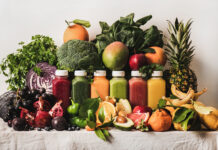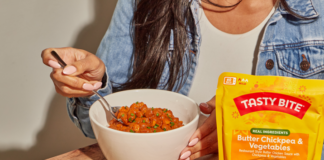
What if the secret to preserving our favorite foods for future generations isn’t about saving traditional ingredients, but reimagining them entirely?

To learn more about how ingredient alternatives can help manufacturers thrive amid supply chain disruptions and rising costs, all while replicating the tastes consumers know and love, we spoke with Adam Maxwell, Founder and CEO of Voyage Foods.
Maxwell developed a passion for food from a young age, starting out as a pastry cook in high-end restaurants at the age of 14. While making his way through college, he discovered food science at McGill University, which inspired him to think about “cooking at factory scale.” After several R&D roles, his career path led to the founding of Voyage Foods.
Voyage Foods, started about four years ago, creates alternatives to food items with uncertain futures due to farming challenges, production problems, or increasing allergies. The company focuses on making replacements for products like chocolate and coffee that taste like the real thing while remaining affordable.
What makes Voyage unique is their commitment not just to environmental sustainability, but to ensuring people can continue to enjoy their favorite foods long-term.
How alternatives help stabilize costs in volatile markets
Volatility in cocoa prices isn’t a new phenomenon — supply chain fluctuations are normal for commodities grown in narrow climate bands and specific regions. While cocoa shortages are making headlines now, the industry has faced multiple supply crunches throughout history. For example, Nutella was created during a World War II cocoa shortage, and hazelnuts were mixed in to extend chocolate supplies.
Voyage Foods helps provide a buffer against this inherent volatility. Their clean-label, low-cost, environmentally friendly alternatives are completely decoupled from traditional commodity markets. For example, their “bean-free coffee” is made exclusively from chickpeas and caffeine, which has zero correlation with global coffee prices. These alternative ingredients are grown worldwide with short growing cycles.
This use of widely available, global commodities that inherently have lower base prices offers manufacturers stability in their bill of materials.
In addition, manufacturers can use these alternatives without worrying about questionable ingredients or processing that may alarm consumers. Voyage’s cocoa-free chocolate uses simple, clean-label ingredients like grape seeds, sunflower flour, sugar, fat, and natural flavors — all “innocuous, real whole ingredients” with nothing hidden on the label. Maxwell emphasizes that “the science is in the lab, not in the factory,” and their production facilities look like standard factories or coffee roasteries, without any exotic or concerning technology that might scare consumers.
Satisfying consumer taste expectations
Formulating alternatives for products like chocolate and coffee presents unique challenges because of their incredible diversity compared to more standardized foods. Unlike milk, where differences are subtle, there are “worlds of chocolates and worlds of coffees” with vast variations.
“Humans globally buy food because of taste and price first,” Maxwell says, making it essential to match the specific taste expectations of each person in each market. People’s “human set points,” their personal reference points for what these products should taste like can vary widely by region. Maxwell notes that Americans and Europeans have different expectations for coffee profiles, making it difficult to create an alternative that satisfies everyone. These products also have strong “provenance” associations (where and how they’re traditionally made), adding another layer of complexity when creating alternatives that don’t match that traditional heritage.
To ensure they meet consumer expectations, Voyage Foods conducts formal, large-scale external sensory testing panels and maintains a robust internal sensory program. However, recognizing that these formal studies with major vendors are expensive and time-consuming, they’ve developed a more agile approach.
Over the past year and a half, they’ve started conducting more frequent, smaller-scale testing at local college campuses. They call this “Project Compass” internally because, while it doesn’t provide results as robust as formal studies, it gives them directional feedback that allows them to gather consumer data with much faster cycle times. While there’s value in well-trained, consistent quantitative descriptive analysis panels, Maxwell emphasizes the importance of getting “live consumer data as quickly as possible.”
The main limitation of this method is geographical — Voyage can’t easily conduct testing in distant markets using their local approach. Despite this constraint, Adam finds their current testing strategy to be “high leverage” for the markets they’re currently in.
Developing innovative, affordable flavors
There’s nothing inherent to coffee beans, cocoa seeds, or hazelnuts that can’t be recreated using different base ingredients. Chocolate and coffee don’t taste the same in their raw forms as they do in final products — raw cacao seeds taste more like “black tea and lychee” than chocolate bars — and peanuts develop their characteristic taste only at certain temperatures during roasting. Thus, the flavors we enjoy aren’t solely from the original ingredient but can also be created through processing.
Voyage’s approach to flavor development involves mapping the molecular changes that occur at each stage of processing these traditional ingredients, from raw form to finished product, to understand the reaction mechanisms that create the flavors we love. This allows the company to take “lower cost, more sustainable, less volatile ingredients” and process them to generate the flavors of cocoa or coffee. For certain flavor notes that can’t be achieved through processing alone (like fruity notes in specialty coffees), they supplement “molecule by molecule” with natural flavors.
The short version, as Maxwell puts it, is “flavor development through process, not input.” Rather than using flavorless base ingredients with added flavors from flavor houses, they transform environmentally friendly, widely available, low-cost substrates into higher-value goods through processing techniques.
The human touch is critical to research and development
Voyage’s R&D process includes several stages — mapping, modeling, sourcing, treating, modulating, thermal processing, and finally, refining and finishing.
While Voyage uses auto-samplers on gas chromatography-mass spectrometry (GC-MS) equipment, Maxwell notes that most lab work in food production isn’t efficiently automated. He believes scientists need to physically interact with materials to understand properties like viscosity, color, rheology, and aromas coming off machines. While he thinks lab automation will increase in the future, he’s not convinced it would necessarily be beneficial.
Regarding AI, Adam is skeptical about industry claims. He questions what companies really mean when they say they’re “using AI.” Are they using predictive models built on trained datasets, repurposing language models like ChatGPT, or simply rebranding what would have been called “predictive data science” five to 10 years ago? He admits that while data processing and modeling are part of Voyage’s process, he’s “dubious of everyone saying everything’s AI.”
His candid conclusion is that Voyage Foods probably uses “functionally no automation or AI, depending on how you look at it.” Instead, the emphasis is on human touch.
Committing to a sustainable mission
When examining lifecycle analyses of products like chocolate, coffee, milk, and meat, Maxwell notes that processing represents a small portion of environmental impact, and transport (especially ocean freight for cocoa) is also relatively minor. The significant environmental benefits come from carefully choosing base ingredients with much lower environmental impacts.
Voyage Foods has invested in ISO-certified, third-party reviewed lifecycle analyses (LCAs) for their products, which is uncommon for companies at their stage. These analyses are robust enough that a company of any size can use them in ESG reporting. Voyage’s approach focuses on developing products with ingredients that inherently have lower emissions and water usage compared to traditional commodities.
While Voyage does practice sustainability internally (using secondhand office chairs, throwing away less), Maxwell believes the biggest cultural impact comes from attracting people who specifically want to work for a company that aligns with their values. Some applicants are drawn to the plant-based aspect of the company, others discovered Voyage through their allergy-friendly products for children, and some studied sustainability and appreciate the company’s unique approach.
Successfully scaling an alternative ingredient business
Maxwell shares some key lessons he’s learned from the process of scaling an alternative ingredient business in a market dominated by legacy suppliers.
His biggest learning was about focus. In the early days, Voyage Foods was spreading itself too thin across multiple channels and categories. They had a food service business serving schools and a retail business with nut-free spreads in Walmart and other retailers. He realized “you can’t do it all at once” and needed to concentrate on what they were specifically good at versus what any other company could do.
About a year ago, Voyage signed a global sales and distribution partnership with Cargill, one of the world’s largest food companies and a major player in cocoa, chocolate, and confectionery ingredients. This partnership has proven beneficial because Cargill could do things Voyage couldn’t. Each company brings their own expertise to the partnership.
“You don’t have to do it all alone” and “you don’t have to do it all at once,” Maxwell says. He admits Voyage probably tried to do too much themselves from the beginning, but as they’ve matured as a company, they’ve focused more on their key advantages and how to deliver them meaningfully.
Voyage Foods is currently transitioning from “startup to scale-up” with a significant expansion in production capacity. Next month, they’re opening a nearly 300,000 square foot plant in Ohio that will increase their production from “metric tons per day to metric tons per hour.” This expansion will enable them to scale both nationally and globally through their partnership with Cargill for cocoa-free chocolate and nut-free spreads and fillings. They also plan to scale their bean-free coffee product line in ways they haven’t been able to previously.
Voyage’s focus is shifting more toward supplying industrial ingredients to large FMCG companies, who will use their products as ingredients in their own offerings. Maxwell is excited about this strategy “coming to fruition in a way that it really hasn’t yet.”
The company aims to help manufacturers both domestically and internationally address various challenges, including:
- Creating line extensions with allergen-free products
- Developing more sustainable confectionery products
- Buffering against volatility in commodity markets
These initiatives represent the “big things on the horizon” for Voyage Foods as they scale their operations.
Thinking outside the box
Some advice Maxwell wishes he had followed earlier is to not blindly accept conventional wisdom about how things should be done. To create meaningful change, you need to do things differently.
Maxwell acknowledges that change is challenging for everyone — for consumers, for manufacturers, and all the way up the supply chain, creating a general hesitancy toward new ways of thinking.
Despite this, he cautions against trying to “fit into the boxes of the world.” Learning to free yourself from those constraints can be powerful.
Learn more about Voyage Foods and their mission at https://voyagefoods.com/.









